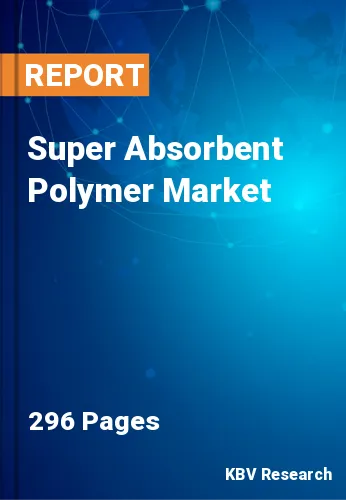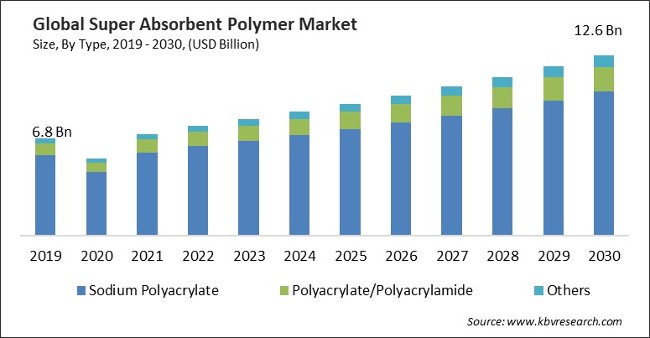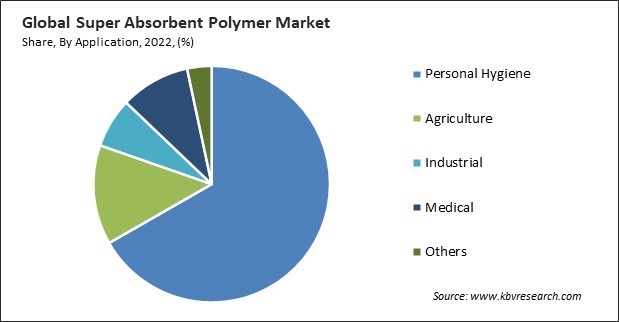
The Global Super Absorbent Polymer Market size is expected to reach $12.6 billion by 2030, rising at a market growth of 6.4% CAGR during the forecast period. In the year 2022, the market attained a volume of 3,168.0 kilo tonnes, experiencing a growth of 4.3% (2019-2022).
Personal hygiene products containing SAPs contribute to improved odor control. Therefore, the Personal Hygiene segment acquired $5,114.6 million in 2022. By efficiently absorbing liquids and trapping them within the polymer structure, SAPs help minimize unpleasant odors. This feature is essential for maintaining freshness and promoting a sense of cleanliness. Personal hygiene products with SAPs contribute to promoting hygienic practices by ensuring efficient moisture absorption. This is especially important in preventing skin problems and infections caused by extended moisture exposure. The promotion of good hygiene practices aligns with broader public health goals. Some of the factors impacting the market are increasing population and urbanization, construction and infrastructure development, and environmental concerns of SAPs.

Diapers, feminine hygiene products, and adult incontinence products are among the personal hygiene items in greater demand due to population growth. SAPs are a critical component in these products, providing efficient absorption and moisture management. Urbanization is often accompanied by changes in lifestyle and an increase in disposable income. Urban dwellers typically have higher purchasing power and are more likely to use advanced personal care products incorporating SAPs for enhanced performance. As urbanization leads to converting rural areas into urban spaces, there is a growing need for efficient water management in agriculture. Additionally, SAPs find applications in the construction industry, where they are used to enhance the properties of concrete and contribute to soil stabilization. The expansion of construction and infrastructure projects increases the demand for SAPs. SAPs are added to concrete mixtures to enhance their properties. Including SAPs improves the workability, durability, and crack resistance of concrete. This is especially beneficial in constructing bridges, roads, and buildings. SAPs contribute to the improved workability of mortar and concrete mixes. This makes construction processes more efficient, allowing for easier handling, placement, and finishing of the construction materials. By improving the durability and resistance to environmental factors, SAPs contribute to the longevity of structures exposed to various weather conditions. The construction and infrastructure development has been a pivotal factor in driving the growth of the super absorbent polymer market.
However, the environmental impact of traditional SAPs, which are not readily biodegradable, has raised concerns. The industry is increasingly pressured to develop and adopt more sustainable and environmentally friendly SAP formulations. Disposing of products containing SAPs in landfills raises concerns about space usage and the environmental consequences of non-biodegradable waste. The breakdown of traditional SAPs into smaller particles can contribute to microplastic pollution. Microplastics can enter ecosystems, including water bodies, soil, and air, posing potential risks to aquatic life, wildlife, and human health. Concerns about the environmental impact of SAP-containing products may lead consumers to prefer alternatives or eco-friendly options, affecting the demand for traditional SAPs. Environmental concerns are a significant challenge that hampers the growth of super absorbent polymer market.
Based on application, the super absorbent polymer market is classified into personal hygiene, agriculture, medical, industrial, and others. The medical segment procured a promising growth rate in the super absorbent polymer market in 2022. SAPs are often used to formulate hydrogel dressings to keep wounds moist and promote healing. Hydrogel dressings containing SAPs are versatile and can be used for various types of wounds, contributing to their widespread adoption in the medical segment. SAPs are utilized in post-surgical dressings to absorb exudate and maintain a clean and healing environment. Their use improves post-surgical care outcomes and reduces the risk of infections and complications. SAPs are explored for their properties, especially in developing hemostatic dressings and products. The ability of SAPs to absorb and retain blood contributes to their potential use in controlling bleeding in various medical scenarios.

By type, the super absorbent polymer market is categorized into sodium polyacrylate, polyacrylate/polyacrylamide, and others. The polyacrylate/polyacrylamide segment covered a considerable revenue share in the super absorbent polymer market in 2022. The demand for high-performance diapers, adult incontinence products, and feminine hygiene items has grown due to the increasing population, rising disposable incomes, and a heightened focus on hygiene. This growth fuels the demand for the polyacrylate /polyacrylamide segment as key components in SAP formulations. Polyacrylate/ polyacrylamide are crucial in SAP formulations used for soil conditioning and water retention in agriculture. As the global population rises, efficient water management becomes imperative for sustainable food production, driving the demand for SAPs.
| Report Attribute | Details |
|---|---|
| Market size value in 2022 | USD 7.7 Billion |
| Market size forecast in 2030 | USD 12.6 Billion |
| Base Year | 2022 |
| Historical Period | 2019 to 2021 |
| Forecast Period | 2023 to 2030 |
| Revenue Growth Rate | CAGR of 6.4% from 2023 to 2030 |
| Number of Pages | 296 |
| Number of Table | 550 |
| Quantitative Data | Volume in Killo Tonnes, Revenue in USD Billion, and CAGR from 2019 to 2030 |
| Report coverage | Market Trends, Revenue Estimation and Forecast, Segmentation Analysis, Regional and Country Breakdown, Porter’s 5 Forces Analysis, Company Profiling, Companies Strategic Developments, SWOT Analysis, Winning Imperatives |
| Segments covered | Type, Application, Region |
| Country scope |
|
| Companies Included | BASF SE, LG Chem Ltd. (LG Corporation), Formosa Plastics Group, Evonik Industries AG (RAG-Stiftung), Kao Corporation, Sanyo Chemical Industries, Ltd., Songwon Industrial Co., Ltd., Nippon Shokubai Co., Ltd., Sumitomo Seika Chemicals Co. Ltd., and Chase Corporation. |
| Growth Drivers |
|
| Restraints |
|
Region-wise, the super absorbent polymer market is analysed across North America, Europe, Asia Pacific, and LAMEA. In 2022, the Asia Pacific region led the super absorbent polymer market by generating the highest revenue share. SAPs in personal care products, including diapers, adult incontinence products, and feminine hygiene items, are widespread in the Asia Pacific region. The Asia Pacific region is characterized by significant population growth and rapid urbanization. The Asia Pacific healthcare industry utilizes SAPs in medical applications, such as wound care products and medical dressings. Increasing awareness of hygiene and health in the Asia Pacific region drives the demand for products that enhance cleanliness and comfort.
Free Valuable Insights: Global Super Absorbent Polymer Market size to reach USD 12.6 Billion by 2030
The market research report covers the analysis of key stake holders of the market. Key companies profiled in the report include BASF SE, LG Chem Ltd. (LG Corporation), Formosa Plastics Group, Evonik Industries AG (RAG-Stiftung), Kao Corporation, Sanyo Chemical Industries, Ltd., Songwon Industrial Co., Ltd., Nippon Shokubai Co., Ltd., Sumitomo Seika Chemicals Co. Ltd., and Chase Corporation.
By Type (Volume, Kilo Tonnes, USD Billion, 2019-2030)
By Application (Volume, Kilo Tonnes, USD Billion, 2019-2030)
By Geography (Volume, Kilo Tonnes, USD Billion, 2019-2030)
The Market size is projected to reach USD 12.6 billion by 2030.
Construction and infrastructure development are driving the Market in coming years, however, Environmental concerns of SAPs restraints the growth of the Market.
BASF SE, LG Chem Ltd. (LG Corporation), Formosa Plastics Group, Evonik Industries AG (RAG-Stiftung), Kao Corporation, Sanyo Chemical Industries, Ltd., Songwon Industrial Co., Ltd., Nippon Shokubai Co., Ltd., Sumitomo Seika Chemicals Co. Ltd., and Chase Corporation.
In the year 2022, the market attained a volume of 3,168.0 kilo tonnes, experiencing a growth of 4.3% (2019-2022).
The Sodium Polyacrylate segment is leading the Market by Type in 2022; thereby, achieving a market value of $10 billion by 2030.
The Asia Pacific region dominated the Market by Region in 2022, and would continue to be a dominant market till 2030; thereby, achieving a market value of $5.4 billion by 2030.
Our team of dedicated experts can provide you with attractive expansion opportunities for your business.
